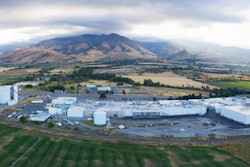Old Dutch Foods–a snack food manufacturing company–has experienced an increase in water usage and operational costs at its Minnesota facilities these last several years and sought an MnTAP intern to identify and quantify the water intensive steps in production and opportunities for reduction or reuse. MnTAP–an outreach program at the University of Minnesota that places highly qualified students in facilities for three months to focus on pollution prevention and energy efficiency solutions–placed Madison Best, a Bioproducts & Biosystems Engineering major at the company.
Old Dutch Foods consumes approximately 35 million gallons of water per year at its Roseville, Minn. location and 20 million gallons of water at its St. Anthony, Minn. location. Best offered the following suggestions:
Add a valve on the washer pump to turn off the water between potato unloading shifts, eliminating unnecessary water use. This would save 460,000 gallons of water and $1,800 annually.
Replace the 9 potato washer nozzles with a higher flow rate (2.3 gpm) than the others (1.5 gpm) for nozzles with lower capacity. This would result in 600,000 gallons of water being saved every year along with $2,000.
Install variable frequency drive on the washer pump to lower the motor speed by 35%, reducing pump water use by 950,000 gallons and electricity use by 37,000 kWh annually, and save $5,000 yearly.
Recycle water to peeler by replacing the fresh water bar used to spray potatoes with a new spray bar supplied with recycled water from the recovery station. This would allow 890,000 gallons to be conserved, saving $3,600 annually.
Eliminate the fresh water fryer hose that Best discovered and replace it with a hose that uses recycled water instead. This would save 3,000,000 gallons and $12,000 annually.
Add a locking valve on the fresh water supply, supplementing with recycled water, at the fryers. This would reduce the water used to wash potato slices before frying by 50% and save 3,750,000 gallons and $16,000 per year.
Add hydrocyclone filters to the water recycling system, which would reduce the starch content in the water so more of it can be recycled and replace fresh water use. This would save 1,250,000 gallons of water and $4,000 annually.
Automate the water recycling system to accurately change the amount of recycled water that is processed and sent to various parts of the facility, utilizing more of the recycled water. These updates could save 3,000,000 gallons of water and $29,000 annually.
Install a disk stack centrifuge at the St. Anthony location to clean wastewater so it can be used to wash and soak corn, reducing fresh water use by 5,000,000 gallons leading to a cost savings of $100,000 annually.
Replace nozzles at the St. Anthony location that have a flow rate of 1.4 gpm with the 0.85 gpm model. Lower capacity nozzles have the potential to save 750,000 gallons and $15,000 per year.
“Working as an intern at Old Dutch was a great opportunity for me to gain experience working in a food manufacturing environment,” says Best. “Seeing what goes into the implementation of sustainable solutions on such a large scale was a beneficial experience, and I was able to learn a lot about the intersection of engineering, business, and sustainability. The internship greatly influenced my choice to pursue a future career in which I can utilize my engineering and communication skills to influence manufacturing practices.
Old Dutch Foods expresses how helpful Best was in analyzing its processes and says it will be implementing the proposed solutions in the near future. The project results not only benefit Old Dutch facilities, but contribute to on-going efforts in Minnesota that focus on industrial water efficiency for the preservation of groundwater. These efforts are supported by Metropolitan Council Environmental Services, through the Clean Water, Land & Legacy Amendment.
To download and view the 2020 MnTAP project results, click here.
Other articles you may be interested in:
MnTAP Provides Sustainable and Cost-saving Solutions
McCormick Ranked World’s 6th Most Sustainable Corporation
Unilever Engineers Fit a Factory Into a 40-foot Container





















